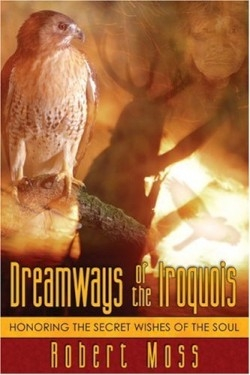Dreamways of the Iroquois
Honoring the Secret Wishes of the Soul
Suspend disbelief. What if past and future, healing and protection, soul, spirit, guides, and life purpose are available to anyone through dream travel? For linear rational thinkers, it may be a stretch, but the author brings urgent messages from a long lineage of dreamtimes wisdom elders.
Moss is a former professor of ancient history at the Australian National University, and has written Conscious Dreaming, Dreamgates, and Dreaming True. In part one of this book, he shares his personal odyssey as a lifelong dreamer. Synchronicities and connections led him to turn his back on a successful career as a thriller novelist. He teaches courses in active dreaming, creativity, and the mystery traditions, currently focusing on “midwifing the birth of a dreaming society in our times.” Childhood illnesses, including several “near death” experiences, proved to the author that there are worlds beyond the physical. But are dream worlds real?
According to the ancient Iroquois, whom Moss counts among his dream teachers from many indigenous traditions, the dream world is whats “real.” They consider the consensual hallucination of solidity the “shadow” world. Awakening to this deeper reality is critical now, assert the author and his teachers, since without dreaming the world is on the road to Dark Times.
Moss retells the Iroquois sacred stories, weavings of myth and history. Drawn anew from the well of dreamtime, his fresh interpretations re-create the world and renew its lost energies. He recounts Iroquois creation stories, including the Birth of the Twins (accounting for planetary polarities), the Peacemaker story, and the spiritual meaning of Hiawatha.
The ancient stories are followed by the teachings of Island Woman, one of the authors primary dream teachers, herself an ancient Huron and Mohawk woman of power. With Moss as interpreter, Island Woman speaks in her own voice on sorcery, big dreams, soul, and animal spirits.
Although most consider dreaming a solitary experience, Moss shows readers the keys to active conscious dreaming-alone, with a partner, and in groups. The author emphasizes how important it is to take actions that honor dreams, to create safe space for sharing dreams, and to extend the dream experience through drama, song and dance, drawing, poetry, and storytelling. Excellent references, including a glossary of Iroquois terms and community dream circle guidelines, complete the package.
Moss poses a question for modern times: “When everything we hold dear and decent seems to be imperiled-when even the dreaming seems to have been hijacked by monsters-what are dreamers to do?” Timely and significant, this is a powerful and richly satisfying combination of myth, history, dream-tellings, stories, poems, and practical tools for “reaching for the sky.” It provides answers for improving the everyday discipline of dreaming in a culture that has all but lost its soul by forgetting to dream.
Reviewed by
Bobbye Middendorf
Disclosure: This article is not an endorsement, but a review. The publisher of this book provided free copies of the book to have their book reviewed by a professional reviewer. No fee was paid by the publisher for this review. Foreword Reviews only recommends books that we love. Foreword Magazine, Inc. is disclosing this in accordance with the Federal Trade Commission’s 16 CFR, Part 255.

